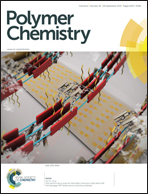Functionalized cellulose nanocrystals as nanocarriers for sustained fragrance release†
Abstract
The desire to extend the release time of highly volatile scents has led to the development of different types of fragrance release systems. We here report a new family of nanocarrier-based pro-fragrances, which have a high affinity to cotton textiles and release their payload under everyday life conditions. The new release systems were created by decorating cellulose nanocrystals (CNCs) with β-damascone, using a short linker that serves to bind the fragrance molecules to the CNC surface and permits their slow release via a retro 1,4-Michael-type reaction. The fragrance release was investigated in aqueous suspensions by gas chromatography coupled to mass spectrometry as a function of pH; the data show that the new pro-fragrances are stable under acidic conditions, but release the β-damascone at basic pH. The chemical resemblance of the CNCs and cotton was thought to be beneficial in terms of adhesion of the nanocarriers on textile substrates, which is an important requirement for the use of pro-fragrances in laundry applications. Thus, the deposition of the new pro-fragrances onto cotton and subsequent fragrance release were probed by dynamic headspace analysis in combination with gas chromatography. The data show that β-damascone is indeed slowly released, and that the quantity of fragrance released after 3 days is up to 80 times higher than in the case of reference experiments, where the tissue was treated with the neat fragrance under identical conditions.


 Please wait while we load your content...
Please wait while we load your content...